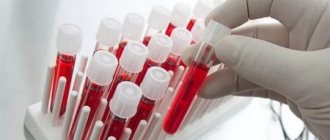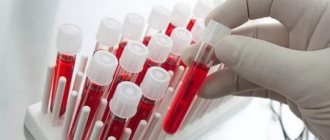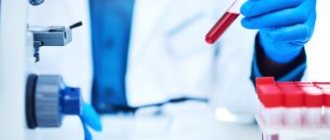In the laboratory of the CMD Central Research Institute of Epidemiology, you can take a stool test for the following types of research:
- General analysis of stool - coprogram
- Fecal Occult Blood Test
- Feces for occult blood (Colon View Hb/Hp) (Colon View hemoglobin (Hb) and hemoglobin/haptoglobin complex (Hb/Hp))
- Fecal analysis for helminth eggs
- Analysis of stool for helminth eggs and protozoan cysts using a Parasep concentrator
- Stool analysis for carbohydrates
Coprogram
A coprogram is a general clinical study that includes the study of physicochemical properties and microscopic examination of feces.
The coprogram allows you to evaluate the function of the stomach and pancreas, liver dysfunction, the speed of food passage through the digestive tract, the presence of inflammatory, destructive changes, and absorption processes in the intestine. A general stool analysis is also informative in the diagnosis of colitis, intestinal infections, and dysbacteriosis.
During the study, it is possible to detect pathological impurities that indicate the presence of a pathological process in the organs of the gastrointestinal tract: ulcerative defects, helminthic infestations, intestinal tuberculosis, disintegrating tumors, etc.
Stool analysis includes assessment of physical properties, chemical analysis and microscopy.
- Physical properties: consistency, shape, color and smell of feces, macroscopic mucus impurities, blood, remains of undigested food.
- Chemical analysis: blood content, bilirubin, stercobilin, leukocytes, pH reaction.
- Microscopy: food residues, epithelium, mucus, crystals, erythrocytes, leukocytes, protozoa, yeast and other indicators.
Danger of parasites
If the number and size of parasites are small, their presence may go unnoticed for a long time. However, the rapid reproduction or growth of parasites and their movement throughout the body during their life cycle often causes serious health problems.
For example, roundworms that accumulate in the intestines can cause constipation and obstruction. Bovine tapeworm grows up to several meters in length and seriously damages the digestive tract, depriving the owner of nutrients and vitamins. Echinococcus forms cysts in internal organs, including the brain, liver, and lungs.
Rupture of such a cyst may occur unexpectedly, after a minor injury or during an examination. The contents of the cyst can cause anaphylactic shock or collapse. Trichinella larvae feed and live in the muscles, gradually destroying them. According to WHO, parasitic diseases account for about 14 million deaths worldwide per year.
Fecal occult blood test
A fecal occult blood test is intended to diagnose hidden bleeding from the gastrointestinal tract (GIT).
The cause of bleeding in the gastrointestinal tract can be erosive or ulcerative damage to organs, varicose veins, helminthic infestations, tumors, diverticula, polyps, hemorrhoids, etc. The intensity of bleeding varies significantly. The most difficult thing to diagnose is small chronic bleeding, which does not manifest itself clinically for a long time.
A fecal occult blood test is also included in the medical examination program and is carried out once every 2 years, starting at the age of 49, for early diagnosis of colorectal cancer.
The CMD laboratory has two options for testing stool for occult blood:
- A fecal occult blood test is used to diagnose hidden bleeding from the lower gastrointestinal tract. The test is based on the detection of red blood cell hemoglobin in the stool.
- Colon View Hb/Hp is a new generation test based on the detection of hemoglobin and hemoglobin/haptoglobin complex (Hb/Hp). The hemoglobin molecule breaks down as it passes through the gastrointestinal tract, and the hemoglobin-haptoglobin complex is a stable form of hemoglobin, so it can be detected even after a fairly long passage through the intestines. Thus, this test is used for screening examination of all parts of the gastrointestinal tract.
What analysis shows the presence of worms?
Blood tests are usually done to confirm the results of stool tests, which often give false results. To determine the presence of worms using a blood test, the following types of laboratory tests are performed:
- General blood analysis
. With worms in the patient's sample, there is an increase in white blood cell levels and a decrease in hemoglobin. An increase in eosinophils and ESR may also indicate parasitic infestation. This study does not allow us to accurately determine the fact of helminthic infestation. - ELISA (enzyme-linked immunosorbent assay).
This study is based on the antigen-antibody reaction. If there are helminths in the patient’s body, the immune system produces specific immunoglobulins (antibodies) to them. A blood test for antibodies to worms allows you to accurately determine the fact of infection, as well as determine the type of parasite. IgG, IgA, and IgM antibodies are used as the main indicators of helminthic infestation. An ELISA test allows you to determine the presence of several parasites in the host’s body at once.
Sometimes liver tests and PCR diagnostics are additionally performed to confirm the diagnosis.
Analysis of stool for helminth eggs and protozoan cysts
Helminths (worms) are parasitic worms that live in the body of humans and animals and cause diseases called helminthiasis (helminthic infestations). The disease in humans is most often caused by roundworms (nematodes) and flatworms (platytodes), which are divided into tapeworms - cestodes and flukes - trematodes. Helminths change their host in the process of life development, and the range of hosts, routes and mechanisms of transmission are individual.
Clinical manifestations are largely determined by the localization of the parasite, its number and feeding habits. Helminths, parasitizing in the human body, can have a mechanical effect, damaging the tissues and organs of the host, toxic and allergic phenomena, metabolic disorders, closing the lumen of the intestines, excretory ducts of the liver, gall bladder, pancreas, disrupting intestinal motility, irritating the receptors of the intestinal wall.
Protozoa are single-celled organisms. Like helminths, during the development process protozoa go through several stages and change hosts. Many protozoa have two forms of existence - vegetative and cystic. The cyst has a durable shell and ensures the survival of the protozoan in unfavorable, and even extreme, conditions. It is cysts that usually infect humans.
A stool test for helminth eggs and protozoan cysts must be taken if a parasitic infection is suspected, to monitor the effectiveness of antiparasitic treatment, before hospitalization, when preparing a medical record, or certificates. For example, for children before visiting the pool.
In the CMD laboratory, stool analysis for helminth eggs and protozoan cysts is carried out using two different methods:
- Feces for helminth eggs and protozoan cysts: microscopic method; "thick smear" method and Kato staining
- Modified sedimentation method using PARASEP concentrators (enrichment method). Analysis of feces for helminth eggs and protozoan cysts using a Parasep concentrator: the use of PARASEP concentrators makes it possible to identify helminths and protozoa even in small quantities.
Description
The study is aimed at identifying parasites living in the human gastrointestinal tract. This study allows you to identify helminth eggs, protozoan cysts and oocysts. A special feature of the study is the use of the sedimentation ether-formalin method in a special Parasep tube, which significantly increases the detection of helminth and protozoan eggs in stool, unlike other stool research methods. But it must be borne in mind that a single negative stool test does not rule out parasitic infection.
For final verification of the diagnosis, three stool examinations are performed, at intervals of up to several days.
Important! This study is not intended to identify adult helminths!
The Parasep system allows you to detect the following helminths and protozoa:
HELMINTHS:
- Trematodes: opisthorchis (cat fluke), dicrocoelia (lanceolate fluke), fasciola (liver fluke), Shikhobalova nanophyte;
- Cestodes: pork (armed) tapeworm (tapeworm), bovine (unarmed) tapeworm (tapeworm), dwarf tapeworm, diphylobothria (wide tapeworm);
- Nematodes: whipworm, pinworm, roundworm, trichostrogylids, hookworm (hookworm), necator (New World hookworm).
PROTOZOTS:
- Class Flagellates: Giardia intestinalis (cyst form);
- Class sercodaceae: intestinal amoeba (cyst form).
The effect of parasites on the body is very diverse. They can cause toxic and toxic-allergic manifestations, have a traumatic effect on the intestinal wall and cause bleeding of varying degrees of intensity. Parasites can also cause obstruction (blockage) of the intestinal lumen and hepatic ducts - this leads to the development of intestinal obstruction and mechanical hepatitis. In addition, all helminths use nutrients from the host’s intestines, which leads to metabolic disorders and reduced levels of vitamins in the body. At the initial stages of infection, the clinical picture is nonspecific: general malaise, possible fever, eosinophilia, leukocytosis. Later, clinical manifestations associated with the localization and quantity of the pathogen appear.
The routes of infection depend on the type of pathogen. One of the most common is the fecal-oral mechanism of infection, when a sick person, carrier, or animal releases parasite eggs into the environment (soil, water) with feces. Of primary importance are vegetables and fruits, salad greens on which there are particles of contaminated soil. Infection often occurs when ingesting water while swimming or drinking unboiled water from springs and reservoirs. Some parasites (opisthorchids) infect freshwater fish. Infection occurs after eating thermally unprocessed fish (sushi, tartare). It is also possible to become infected with tapeworm by consuming unprocessed meat from cattle or pork.
Stool analysis for carbohydrates
Stool analysis for carbohydrates is used to diagnose congenital or acquired deficiency of the lactase enzyme in children of the first year of life.
Lactase is an enzyme that is produced by intestinal epithelial cells (enterocytes) and participates in the biochemical reaction of the breakdown of lactose, otherwise known as milk sugar. When consuming milk and dairy products, if there is not enough lactase, digestion is disrupted and unpleasant symptoms appear: diarrhea, flatulence, cramps, etc.
Causes of lactase deficiency:
- decrease in enzyme production by intact enterocytes due to genetic defects or physiological immaturity of enzyme systems in children of the first year of life - primary, or congenital, lactase deficiency;
- a decrease in enzyme production due to damage to enterocytes during an inflammatory or other (food allergy, tumor) process - secondary, or acquired, lactase deficiency.
Indications for taking a stool test for carbohydrates:
- the presence in children of symptoms such as flatulence, frequent regurgitation, diarrhea, cramps, abdominal pain;
- control of correct diet selection.
How to find out if there are parasites in the body?
A person may suspect they have parasites based on their characteristic signs. The most common symptoms of parasitic infestations include:
- itching in the anus,
- grinding teeth in sleep;
- peeling of the skin;
- the appearance of allergic rashes on the skin;
- unstable chair.
Only a thorough medical examination can confirm or refute the presence of parasites in the body.
Today, many laboratories offer a huge number of tests to identify parasitic infestations. However, it is difficult for a person without medical knowledge to understand such diversity. Therefore, before the examination, it is advisable to visit an infectious disease specialist .
Given the amount of symptoms and syndromes that can develop against the background of chronic parasitosis, only a doctor can adequately assess the importance and advantages of certain diagnostic methods. In addition, during the collection of anamnesis and examination, a specialist can identify direct or indirect signs of parasitosis that the patient himself did not pay attention to.
How to prepare for a stool examination?
In agreement with the attending physician, 2 days before the study, medications that affect intestinal motility (laxatives, enzymes, sympathomimetics) are discontinued; drugs that affect the blood coagulation system (acetylsalicylic acid, warfarin, non-steroidal anti-inflammatory drugs); rectal suppositories and medications, the impurities of which in stool change its color.
The study is carried out no earlier than 2 days after an X-ray examination of the stomach and intestines using contrast agents. It is prohibited to collect stool from diapers, after an enema, during menstruation or within 3 days before or after it, in the presence of bleeding hemorrhoids, bleeding with prolonged constipation, with impurities of urine or discharge from the genitals, with pieces of undigested food.
Biomaterial for analysis is accepted in a sterile plastic container, which can be obtained free of charge at any CMD office.
After natural bowel movements, feces are collected in a container with a spoon and a screw cap in the amount of 1/3 of the container’s volume from 3-5 different places. Avoid contact of the biomaterial with the surface of the toilet bowl. Delivered to the laboratory in a primary container. Screw the container lid tightly.
To analyze stool for carbohydrates : stool from a pre-disinfected pot or bedpan (you can use a plastic bag or oilcloth) is collected in a sterile disposable container. Take a small amount (4-5) from several places with a disposable spatula attached to the lid of the container. If the stool is liquid, then a small amount, no more than 5 ml, should be poured into a container. Close the container lid tightly. Delivery to the laboratory on the day of collection of the biomaterial.









